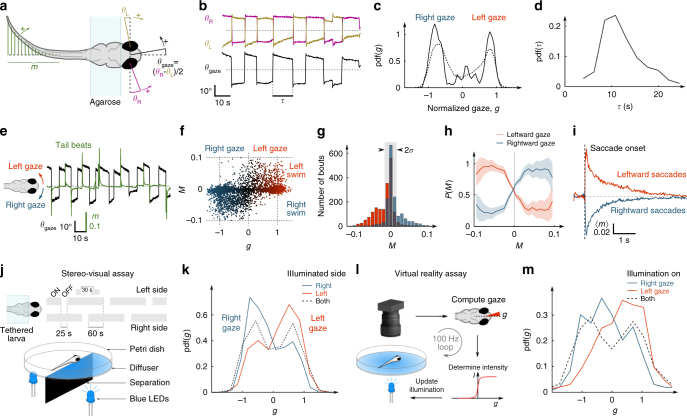Fig. 1.
Behavioural assays of ocular-saccade–turning-bout coordination and light-induced gaze bias. a Definition of the eye and tail kinematic parameters. The larva’s tail and eyes are free. The gaze angle, θ gaze, is defined as the mean orientation of both eyes. The parameter m characterises the instantaneous tail deflection (Supplementary Methods). b–d Gaze dynamics. b Example time-traces of the eye and gaze angles. c Probability distribution function (PDF) of the gaze angle, normalised by its characteristic range (Supplementary Methods), for one fish (solid line) and for N = 29 fish (dashed line). d PDF of the delay τ between successive reorienting saccades for one fish. e–i Ocular-saccade–tail-beat coordination. e Gaze angle and tail deflection signals. f Individual tail-beats turning score M, defined as the integral of m(t) over the swim-bout (Supplementary Methods), vs. the normalised gaze angle g (3681 tail-beats, N = 11 fish). g Histograms of M for leftward (red) and rightward (blue) gaze orientation. The central part of the distribution (standard deviation σ) is used to assess the significance of the tail-bout orientational bias. h Conditional probability of the gaze to be orientated to the left (red) or right (blue) given the tail-beat turning score M (3681 tail-beats, N = 11 fish). The shaded region corresponds to the s.e.m. i Mean peri-saccadic tail deflection signal averaged over leftward (blue) and rightward (red) saccades. j, k Stereo-visual phototaxis. j Scheme of the experimental assay. k PDF of the normalised gaze during periods of unilateral stimulation for animals displaying positive phototaxis (N = 18 fish). Red and blue curves correspond to illumination on the left and right eye, respectively. Dashed curve indicates bilaterally symmetric illumination. l, m Spatio-temporal gaze phototaxis. l Scheme of the virtual-reality assay. The fish is submitted to a uniform illumination whose intensity is driven in real-time by the animal’s gaze angle. m PDF of the normalised gaze angle for virtual leftward (red) and rightward (blue) illumination (N = 13 fish). The dashed curve corresponds to the neutral runs (constant illumination)

